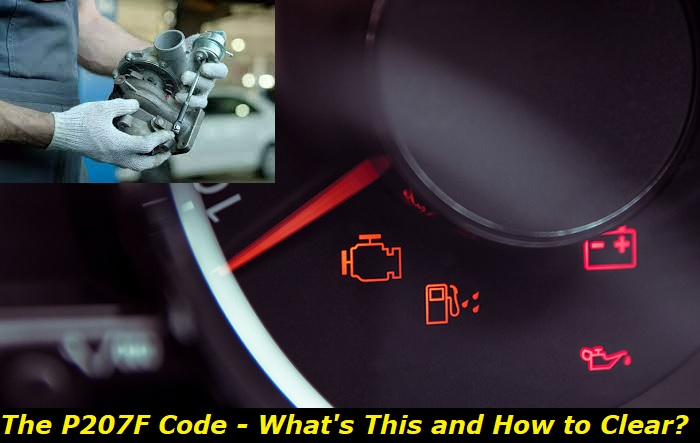Broadly speaking, if your vehicle's check engine light is on, and a P207F error code is displaying, it means there is an issue with its emission system. And you need to clear this code and resolve the underlying issue to prevent further emissions and maintain optimal vehicle performance.
P207F code highlights
- Level of urgency:Medium
- Possible culprits:DEF system, catalytic converter, emission sensors
- Price for repair:$50 - $1,000
- If neglected:Limp mode, failing of emission test
- DIY repairs:Possible but may be complicated
- Can you drive?Yes

What Does the OBD P207F Code Mean?
The P207F code, simply referred to as "Reductant Quality Performance", is a generic DTC inherently found in diesel engines fitted with Selective Catalytic Reduction (SRC) systems. It is usually stored in the PCM if the reductant performance is down and the SRC system isn't efficiently breaking down NOx emissions from the engine.
That said, the P207F code is classified as a generic DTC because it doesn't point to a specific problem. Instead, it simply indicates the presence of a malfunction within the emission system, which could be caused by various issues. Some of these issue include:
- A bad reductant pump
- A defective SRC catalyst
- A diluted, degraded, or incorrect diesel exhaust fluid
- A defective NOx sensor
- An exhaust system leak
Common Signs of the P207F Code?
The good thing about the P207F fault code is that it is easy to spot from a mile away. This means that the chances of you driving around oblivious of its existence are pretty slim. Some of the tell-tale signs of the P207F fault code are:
- The Check Engine Light comes on and stays lit.
- The dashboard displays a "Service DEF System" message
- The engine keeps stalling or going into idle mode
- A noticeable decrease in overall engine performance.
- Black smoke emits from the exhaust pipe.
- Decreased fuel efficiency.
- Reduced engine power and poor acceleration.
- Difficulty in starting the car
How to Clear the P207F Code
Now that you know the common signs and performance implications of the P207F fault code, you are probably looking to clear the code at your earliest convenience. However, you will only be able to permanently clear the code if you first find and resolve the underlying issue. So before embarking on clearing the P207F, make sure the underlying problem has been fixed.
That said, here are the two methods you can use to clear the P207F fault code.
Method 1: Using the OBD-II Code Scanner
- Buy, loan, or borrow an OBD-II code scanner.
- Locate the OBD port underneath the steering column and plug in the cord attached to the code scanner. The OBD port will typically look like an old VGA port and will have two rows of 8 small openings.
- Insert the key into the ignition and switch the vehicle to "on", but do not start the vehicle.
- Once the lights on the dash come on, switch off all the vehicle accessories and press the "read" button on the scanner.
- Press the "erase/clear" button on the scanner until you see a "no codes" message displayed. The Check Engine Light will also turn off at this point.
- Turn off the ignition and unplug the code scanner.
Method 2: Disconnecting the Battery
- Turn off the vehicle, pop up the hood, and locate the battery.
- Using a wrench, remove the negative cable (usually covered with a black cap and marked with a minus sign) from its terminal.
- Drain electricity from the capacitor by either pressing and holding the horn for 30 seconds or by temporarily switching on the vehicle's lights.
- Leave the battery disconnected for 15 minutes to ensure all the vehicle's systems, including the PCM will completely reset.
- Reconnect the battery by securing the negative cable back to its terminal and covering it with its cap.
- Turn on the vehicle and confirm that the check engine light has been reset and the P207F code cleared.
Causes of the P207F Code
As earlier mentioned, the P207F code can be triggered by several factors. Here are some common issues that can trigger it.
1) Faulty Reductant Pump
If the reductant pump is faulty, it will be unable to efficiently pump and circulate the diesel exhaust fluid through the exhaust gas reduction system. As a result, the system will be unable to optimally neutralize the dangerous exhaust gases from the engine.
2) Defective NOx Sensor
The exhaust after-treatment system is fitted with two NOx sensors, one on the upstream section, and another one on the downstream. The upstream sensor (NOx1) is located on the turbocharger elbow downpipe while the downstream sensor (NOx2) is located at the outlet of the SRC catalyst. Both NOx sensors work together to monitor the efficiency of the SRC Catalyst and the dosing process.
If any of the sensors stops working or malfunctions, the NOx sensor module, will detect inaccurate NOx concentrations and notify the PCM. The PCM will then store a P207F code and illuminate the Check Engine Light.
3) Diesel Exhaust Fluid Issues
A DEF Quality sensor is usually mounted on the DEF tank and is tasked with monitoring the levels and concentration of the diesel exhaust fluid. This sensor will then send the collected information to the PCM over the J1939 Data Link.
If the DEF Quality sensor detects that DEF concentration has fallen below normal, it will trigger a P207F code. Additionally, an "Incorrect DEF Detected See Dealer" message will be displayed on the dashboard. On the other hand, if an issue other than low concentration is detected, a "Service DEF System See Dealer" message will be displayed.
A defective DEF Quality sensor or a degraded, diluted, or incorrect diesel exhaust fluid will also trigger a P207F fault code.
4) Defective SRC Catalyst
The SRC system is fitted with a catalyst that speeds up the reduction of NOx in exhaust fumes. If this catalyst isn't working effectively, it will result in an inefficient reduction of the nitrogen oxides.
5) Exhaust System Leaks
If the vehicle exhaust system is leaking, it means the various sensors installed along the system will not be able to accurately measure the emission quality.
6) Clogged DFP Filter
A clogged diesel particulate filter will restrict the circulation of the diesel exhaust fluid, meaning the SRC system will be inefficient in reducing harmful nitrogen oxides in the exhaust gases.
7) PCM Malfunction
In some cases, the P207F error code can be triggered by a PCM malfunction. This can typically be caused by incorrect harness connections, damaged connector locks, a damaged weather seal, bent terminals, and water intrusion. Overheating of the PCM due to poor connections can also trigger the code.
How to Resolve the P207F Code
Owing to the number of factors that can trigger the P207F code, it is to be expected that there is no universal solution to fixing it. In this section, we will examine some of the solutions and fixes you can administer to resolve a P207F fault code.
1) Replace any defective sensors and clean dirty ones
Several different defective sensors can trigger a P207F fault code. It is, therefore, upon you to carry out diagnostic tests and point out the malfunctioning sensor and replace it to fix the P207F code. Also, if the malfunction in the sensor is caused by dirt or debris deposits, you should clean them out.
2) Top up or replace the DEF
Check the level of the diesel exhaust fluid and if it is low, top it up. Also, collect a small sample of the diesel exhaust fluid and visually inspect it for any signs of contamination or debris. Next, test the quality of the DEF and if the quality is poor, drain and replace it.
3) Fix any loose or damaged PCM harness connections
Disconnect all PCM harness connectors, components, and any related in-line connections. Visually inspect them for any damages and corrosion. Repair or replace any damaged components and connect them back, ensuring that all connectors are fully seated and the locks fully engaged.
4) Clean any clogged filters
Visually inspect and clean the various filters in the transmission system to ensure smooth flow of air (in the intake manifold) and diesel exhaust fluid in the exhaust system.
5) Repair the reductant pump
If the P207F code is triggered by a faulty reductant pump, repairing any damages in it will optimize the vehicle's reductant quality performance.
6) Replace the SRC Catalyst
If the SRC catalyst has reached the end of its design life, you need to add a new catalyst layer or entirely replace it to maintain optimum SRC performance.
Final Thoughts
The P207F code means that your vehicle has an emission-related problem. Theoretically speaking, it isn't a critical issue and you can drive around with it for a couple of days or even weeks. However, you should fix it at your earliest convenience to maintain good vehicle performance and prevent further damage to the affected components.
About the authors
The CarAraC research team is composed of seasoned auto mechanics and automotive industry professionals, including individuals with advanced degrees and certifications in their field. Our team members boast prestigious credentials, reflecting their extensive knowledge and skills. These qualifications include: IMI: Institute of the Motor Industry, ASE-Certified Master Automobile Technicians; Coventry University, Graduate of MA in Automotive Journalism; Politecnico di Torino, Italy, MS Automotive Engineering; Ss. Cyril and Methodius University in Skopje, Mechanical University in Skopje; TOC Automotive College; DHA Suffa University, Department of Mechanical Engineering






Add comment